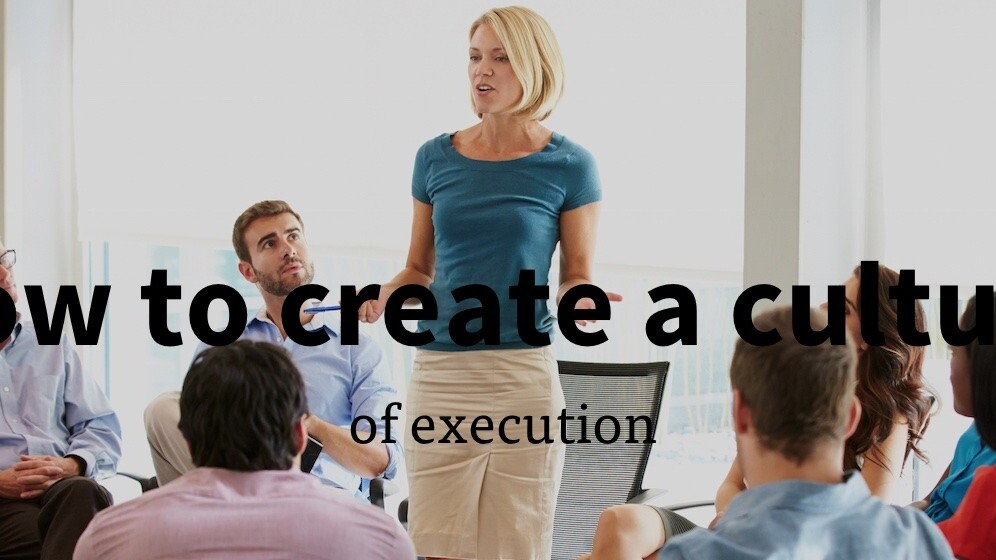
Max Bennett is VP of Business Strategy for Bluecore.
Many early stage tech companies talk about “getting sh*t done” as a foundational component of a successful culture. There are many permutations of this idea in the tech zeitgeist: “a bias for action” (Amazon), “move fast and break things” (old Facebook principle), “Always be shipping”, et cetera.
While these are nice quotations to plaster on a wall, they are largely unhelpful because they fail to describe an underlying mechanism that can be enforced, fostered, and protected. After taking part in establishing a culture worthy of all of these quotations at Bluecore, it became clear that the underlying mechanism is in fact a very simple individual impulse that I call the See-Something. DO Something principle. (SSDS).
The SSDS impulse is that insatiable need to overcome and solve problems that talented people feel when presented with new challenges. A culture of execution is one where when any member of a team perceives a challenge, their first and most immediate reaction is simply to solve it.
This holds true whether it be in relation to hitting a sales goal, completing an integration, or launching a product. While most people have some semblance of this impulse, there are often a variety of obstacles that prevent this impulse from driving action, such as politics, fear of failure, or an aversion to stepping on other people’s toes.
Below are four operating principles that bring the SSDS impulse to life, and some basic tactics to enforce them.
Cross-functionality must be not only encouraged but also expected
A common theme in large companies is the politics around “roles” and “silos”. An engineer with an idea for a sales demo at a normal company would keep his/her ideas to him/herself. This is unacceptable. The dependencies between teams are too massive at a startup for the communication architecture between them to be managed solely by managers.
It is substantially more efficient for different teams to translate their thoughts directly to the appropriate stakeholders. In order for ideas and feedback to be effectively and cross-functionally communicated, both (a) the ideator has to want to help other parts of the organization, and (b) the receiver of feedback has to want to receive it. Here are two ways to help make that happen:
- Cross-Functional Rotations: have each member of a team have to sit with other teams for a week each quarter. If each engineer has to sit with the sales team for one week every quarter, they will naturally feel more comfortable contributing to the sales process. Maybe even have an engineer do some cold calls, trust me it is a fun activity to watch!
- Cross-Functional Social Events: creating social events that facilitate different teams building stronger relationships with each other goes a long way to opening the doors for cross-team collaboration in the workplace. They can be as simple as company-wide happy hours, or facilitating the whole team having lunch together every day.
Egos must be subjugated
In order for the SSDS impulse to operate it is imperative that no one be too good for any single task. Rather, getting one’s hands dirty should be glorified and lauded accordingly. Should your VP of Sales create your new employee onboarding process? If he has the bandwidth and know how, absolutely yes. Don’t let that job title get in the way of progress. Here are some ways to enforce this:
- Screen For Ego: The most important way to enforce this is to explicitly screen candidates for inflated egos before they ever end up on your team. Two basic interview questions that can reveal such an ego include “what is something you are working to get better at?” or “what is an example of you changing your mind?”
- “What I Learned” Discussions: Include a section in weekly standups where teammates can discuss what they learned over some the last week. This is a powerful way to set a tone of constantly being in the process of improving. If you learned something, it means you didn’t know it before, and it means you had room to improve. This also has the beneficial side effect of sharing knowledge between people on the team.
The team must feel safe, but deeply accountable
Everyone must inherently trust that credit will be shared, that failure will be appreciated for its lessons, and that weaknesses will be supported by teammates. The easiest way to ruin the SSDS impulse is to make people feel like they have to perpetually watch their own back. Why would anyone challenge their manager, give feedback to another part of the organization, or go above-and-beyond on a project, when all he/she can think about is their own security? One simply wouldn’t.
However, note that safety is not the same thing as lack of accountability. In fact, the opposite is true: when the SSDS impulse operates freely, everyone on the team feels so deeply accountable for the success of the greater team that they no longer care about who gets credit or whose idea wins, they only care that the right decision is made and that the overarching challenge is overcome. Some ways to make this happen:
Have All-Hands Meetings Consistently Discuss Challenges
At weekly all-hands meetings, make it a routine for everyone (or each team lead) to speak openly about challenges, failures, and what they personally didn’t do well. Further, encourage managers to openly talk about their own failures or roadblocks. This will make it less taboo to discuss struggles openly across the ranks.
Publicize Individual Contributions
Ad hoc accolades of individual or team contributions are valuable, but they are easily forgotten. It is far more powerful to have permanent records of individual contributions to a company’s story. Sales organizations do this very well by having leaderboards and sometimes even public prizes to challenges.
But even less measurable parts of an organization should find ways to codify the monumental contributions of individuals. One such idea we have had at Bluecore is a company timeline in our office that is updated each month to contain milestones that were achieved and who helped the company do so.
When There Is A Fire, Put It Out, Don’t Point Fingers
When someone on the team inadvertently creates a fire, such as deploying buggy code, everyone on the team will watch very closely to how a culture responds to this. It is important for the first response to be to immediately solve the problem and help the individual.
Even in the extreme case that an individual continuously reveals himself to be incompetent and ends up having to be let go, it is important that the team as a whole sees that the company invested in trying to make that person successful. I’ve always remembered how Nicole Glaros (MD at TechStars) put it: “I am 120 percent behind people, until I’m not”. There is no middle ground.
People must align quickly.
Challenging people, giving feedback, and discourse needs its limits. There are diminishing returns to open argumentation. A team should only do so insofar as is useful to make an informed decision. When a final direction is established, the folks on the team who did not get “their way” have to be fully supportive of the decision that is made.
Otherwise, the team is pulled in multiple directions and progress is stalled. This requires a team to care more about solving problems for the greater good (The Company!) than about being personally proven right. Two ways to facilitate this are below:
- Monthly Brain Melds: Having a monthly session where a team can openly be self critical, be skeptical of decisions, and brainstorm new ideas is a valuable way to maintain open discourse without losing alignment. If there is a specific time and place for everyone to openly debate different directions, then such discussions won’t become an ongoing distributed and distracting activity.
- Transparent Corporate Goals: Often misalignment is not a consequence of natural deviations in opinions, but rather a symptom of poor communication. Effectively translating how individual and team goals fits into the entire organization’s goals, and the reason behind them goes along way in aligning people towards a common goal.
When the above four principles are effectively enforced in an environment filled with talented people, you get a freely operating SSDS impulse, which culminates in an incredibly powerful culture of execution. Moreover, in contrast to the nondescript “get sh*t done” mantra written on the walls of many startups, the SSDS impulse describes something tangible to foster and protect when thinking about building a successful culture.
It would be a lie to say this was planned and implemented entirely deliberately at Bluecore. We have undeniably stumbled plenty of times along the way. However, I can say that our culture of execution continues to be one of the single most valuable competitive advantages we have as a company.
Read Next: Designing collaboration inside a new business
Image credits: Shutterstock
Get the TNW newsletter
Get the most important tech news in your inbox each week.









